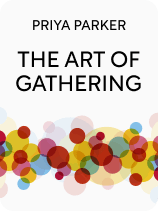

This article is an excerpt from the Shortform book guide to "The Art of Gathering" by Priya Parker. Shortform has the world's best summaries and analyses of books you should be reading.
Like this article? Sign up for a free trial here.
What is the appropriate way to act at a party? Should guests refrain from creating heated disagreements at gatherings?
When attending or hosting a party, many people think there’s a certain way they should act to not damper the mood. However, The Art of Gathering by Priya Parker suggests three rules that will help hosts and guests loosen up a bit so everyone can have fun.
Discover how to act at a party without having to meet certain expectations.
Misconception #1: The Host Should Relax
The first harmful misconception of how to act at a party, according to Parker, is the idea that the host should relax, or “chill.” Hosts who think they should relax leave guests to their own devices—such as by letting guests roam around the venue unrestricted. These hosts see their refusal to direct the gathering as an act of kindness that will result in a laid-back, undirected affair. But in reality, if a host doesn’t direct his own affair, someone else will—usually in a manner that ruins the gathering for everybody else.
Instead, Parker recommends that you shift your mindset and deliberately direct the gathering. In other words, you must use your power as a host to make your guests do things they might not choose themselves. If this seems too stuffy, remind yourself that deliberate direction is kinder than relaxing—as long as it’s motivated by a desire to provide your guests with a maximally fulfilling experience. If you’re motivated by anything else (like a desire to seem more important), you’ll detract from, rather than enhance, your guests’ experience.
Parker explains that deliberately directing your gathering involves doing three things. First, defend your guests against actions that harm the good of the gathering—even if doing so is unpleasant. For example, one movie theater expels guests who use their cell phones during the show. This policy upsets the expelled guests but enhances the other guests’ moviegoing experience.
Second, level the playing field: Identify and temporarily destroy any relevant inequalities. This allows guests to relate to each other as equals, rather than deferring to each other out of societal norms. For example, if you’re hosting a party among people of vastly different career levels, select a restaurant that everybody can afford.
Third, facilitate links between your guests and do things to help them get to know each other despite any discomfort they (or you) might feel. For example, Parker once asked people to switch tables regularly during a conference; despite the guests’ original reluctance, they were ultimately grateful for the number of connections they made.
Misconception #2: Be Positive
The second harmful misconception, according to Parker, is the idea that everybody should be positive. When we gather—whether at a party or conference—most of us put on a show: We present ourselves as strong and confident, and we hide our vulnerabilities. Parker argues that this is a missed opportunity to connect with others. If your guests tell stories that reveal their vulnerability, other guests will feel more empathetic toward them. As a result, they’ll all feel more authentically connected to each other. At the very least, this authentic connection will make for a more memorable gathering; at its best, a deeper connection can allow for greater cooperation.
Parker shares several techniques for encouraging your guests to open up and be vulnerable when the gathering calls for vulnerability. Pre-gathering, consider inviting people who don’t know each other. People often feel more comfortable sharing intimate details with people in whom they’re not invested, as they don’t feel pressured to maintain a particular image.
Parker recommends that you set the stage during the gathering. Begin the gathering by clearly explaining to your guests why you’re asking them to be vulnerable. Then, ask for stories. Specify that you want to hear not about their accomplishments but about something more authentic, such as life-defining experiences. If your guests know each other, request stories that nobody else in the room knows. Once people start sharing, share your story early, and make sure it’s slightly more intimate than those you want your guests to share. Your guests will cue off your example and share stories that are slightly less intimate than yours.
Finally, don’t pressure your guests too much. As a host, you should encourage (but not demand) your guests to share; at one gathering, Parker created a rule that whoever shared last had to sing. However, some people won’t feel comfortable being extremely vulnerable in a group no matter what you do—and that’s OK. So choose a theme that invites interpretation; this will allow such people to be vulnerable within boundaries they’re comfortable with.
Misconception #3: Be Peaceful
The third harmful misconception, according to Parker, is the idea that all gatherings must be peaceful. Parker argues that in the modern world, most of us act as if we should avoid heated disagreements. Even universities—ostensibly institutions designed to encourage argument—shy away from anything too controversial, such as by rescinding invitations to speakers who draw student protests.
However, Parker warns that prioritizing peace above all else can sometimes backfire and undermine your reason for gathering. Certain gatherings require that long-simmering tensions be brought out into the open and worked through—whether that’s because the gathering is about a controversial topic or because the group’s work outside the gathering is being hampered by these tensions. For example, you might hold a debate about gun control, or you might have educators who need to create a curriculum but are debating what kind of ideas they want to teach their students. If you avoid this requirement, you won’t effectively discuss or work through any of these issues—and they’ll continue to sow disharmony.
If you’re intrigued by the idea of encouraging disagreement at your gathering, you’ll first need to decide whether doing so will be helpful. Pre-gathering, identify potential areas of disagreement by asking probing questions of the participants (including yourself). As a group, what are you afraid to talk about? What do people get defensive about, and why? Then, weigh the potential pros and cons of addressing these issues—and only proceed if you feel that the potential pros outweigh the cons.
If you choose to proceed, create a safe space: Try to make participants as comfortable as possible dealing with an uncomfortable topic. Parker suggests that you ask the participants to create guidelines for the discussion by asking them, “How can we help you feel comfortable taking a chance during our discussion today?” Jointly creating guidelines in this manner has three benefits. First, it signals to participants that you’d like them to put themselves out there during the discussion. Second, it prompts the participants to ban undesirable behaviors they’ve resorted to in the past. Third, it encourages compliance—participants are more likely to follow guidelines that they had a hand in creating.

———End of Preview———
Like what you just read? Read the rest of the world's best book summary and analysis of Priya Parker's "The Art of Gathering" at Shortform.
Here's what you'll find in our full The Art of Gathering summary:
- How to make pre-planned gatherings more meaningful and engaging
- What to do before, during, and after any type of gathering
- Why the host should never relax during their event






